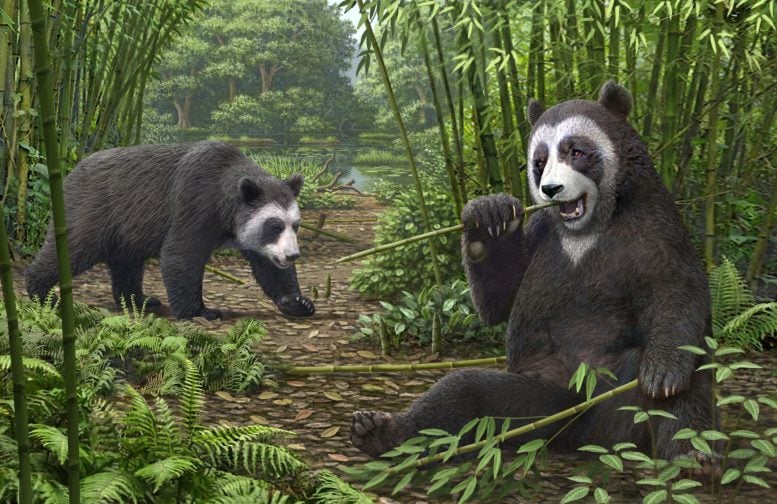
An artist reconstruction of Ailurarctos from Shuitangba. The grasping function of its false thumb (shown in the right individual) has reached to the level of modern pandas, whereas the radial sesamoid may have protruded slightly more than its modern counterpart during walking (seen in the left individual). Credit: Illustration by Mauricio Anton
Eating bamboo? It’s all in the wrist.
When is a thumb not really a thumb? When it’s an elongated wrist bone of the giant panda that is used to grasp bamboo. Through its lengthy evolutionary history, the panda’s hand has never developed a truly opposable thumb. Instead, it evolved a thumb-like digit from a wrist bone, the radial sesamoid. This unique adaptation helps these bears subsist entirely on bamboo despite being bears (members of the order Carnivora, or meat-eaters).
In a new paper published today (June 30, 2022), scientists report the discovery of the earliest bamboo-eating ancestral panda to have this “thumb.” Surprisingly, it’s longer than its modern descendants. The research was conducted by the Natural History Museum of Los Angeles County’s Curator of Vertebrate Paleontology Xiaoming Wang and colleagues.
While the celebrated false thumb in contemporary giant pandas (Ailuropoda melanoleuca) has been known for more than 100 years, it was not understood how this wrist bone evolved due to a near-total absence of fossil records. A fossil false thumb from an ancestral giant panda, Ailurarctos, dating back 6–7 million years ago was uncovered at the Shuitangba site in the City of Zhaotong, Yunnan Province in south China. It gives scientists a first look at the early use of this extra (sixth) digit–and the earliest evidence of a bamboo diet in ancestral pandas–helping us better understand the evolution of this unique structure.
“Deep in the bamboo forest, giant pandas traded an omnivorous diet of meat and berries to quietly consuming bamboos, a plant plentiful in the subtropical forest but of low nutrient value,” says NHM Vertebrate Paleontology Curator Dr. Xiaoming Wang. “Tightly holding bamboo stems in order to crush them into bite sizes is perhaps the most crucial adaptation to consuming a prodigious quantity of bamboo.”
How to Walk and Chew Bamboo at the Same Time
This discovery could also help solve an enduring panda mystery: why are their false thumbs so seemingly underdeveloped? As an ancestor to modern pandas, Ailurarctos might be expected to have even less well-developed false“thumbs,” but the fossil Wang and his colleagues discovered revealed a longer false thumb with a straighter end than its modern descendants’ shorter, hooked digit. So why did pandas’ false thumbs stop growing to achieve a longer digit?
“Panda’s false thumb must walk and ‘chew’,” says Wang. “Such a dual function serves as the limit on how big this ‘thumb’ can become.”
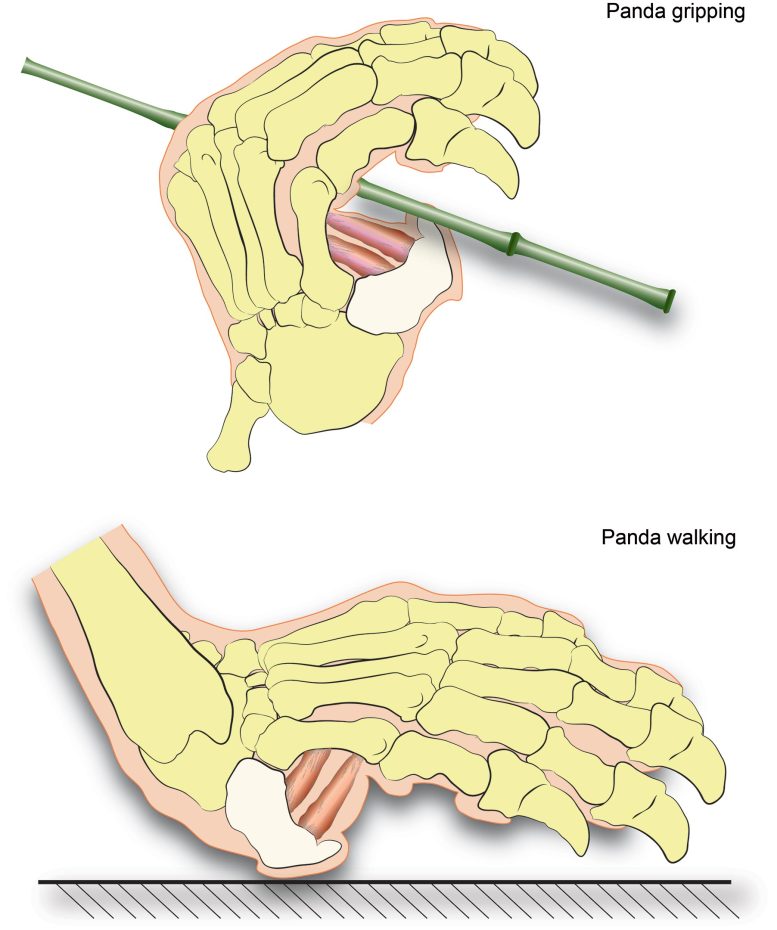
Panda gripping vs walking (white bone is the false thumb). Credit: Courtesy of the Natural History Museum of L.A. County
Wang and his colleagues think that modern panda’s shorter false thumbs are an evolutionary compromise between the need to manipulate bamboo and the need to walk. The hooked tip of a modern panda’s second thumb lets them manipulate bamboo while letting them carry their impressive weight to the next bamboo meal. After all, the “thumb” is doing double duty as the radial sesamoid–a bone in the animal’s wrist.
“Five to six million years should be enough time for the panda to develop longer false thumbs, but it seems that the evolutionary pressure of needing to travel and bear its weight kept the ‘thumb’ short–strong enough to be useful without being big enough to get in the way,” says Denise Su, associate professor at the School of Human Evolution and Social Change and research scientist at the Institute of Human Origins at Arizona State University, and co-leader of the project that recovered the panda specimens.
“Evolving from a carnivorous ancestor and becoming a pure bamboo-feeder, pandas must overcome many obstacles,” Wang says. “An opposable ‘thumb’ from a wrist bone may be the most amazing development against these hurdles.”
Reference: “Earliest giant panda false thumb suggests conflicting demands for locomotion and feeding” by Xiaoming Wang, Denise F. Su, Nina G. Jablonski, Xueping Ji, Jay Kelley, Lawrence J. Flynn and Tao Deng, 30 June 2022, Scientific Reports.
DOI: 10.1038/s41598-022-13402-y
The authors of this article are affiliated with the Natural History Museum of Los Angeles County, Los Angeles, CA, USA; Institute of Vertebrate Paleontology and Paleoanthropology, Chinese Academy of Sciences, Beijing, China; Arizona State University, Tempe, Arizona, USA; Pennsylvania State University, University Park, Pennsylvania, USA; Kunming Institute of Zoology, Chinese Academy of Sciences, Kunming, Yunnan, China; Yunnan Institute of Cultural Relics and Archaeology, Kunming, Yunnan, China; Harvard University, Cambridge, Massachusetts, USA.
Funding was provided by the U.S.A. National Science Foundation, Yunnan Natural Science Foundation, National Natural Science Foundation of China, the Governments of Zhaotong and Zhaoyang, Institute of Vertebrate Paleontology and Paleoanthropology.

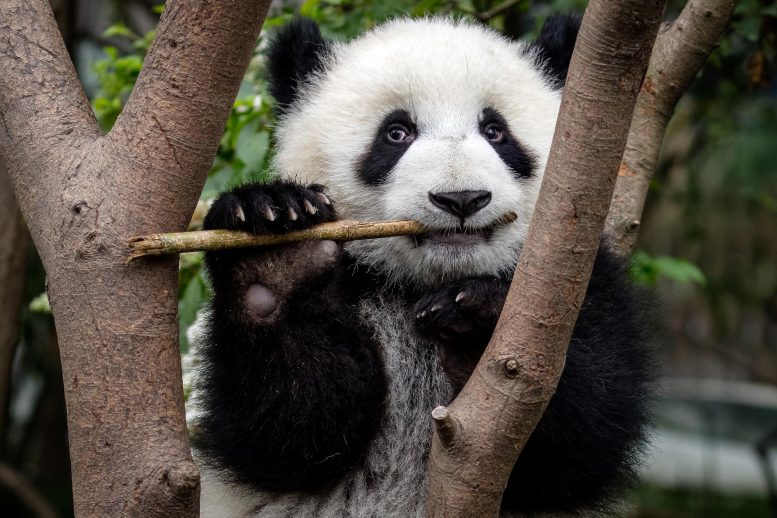
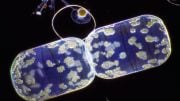


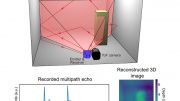


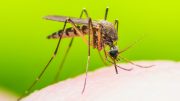

Also, Rabbits’ Feet are useless like ours. Geneticists should make serious attempts to make them Hands like Feet of Rhesus Monkeys.
Does this ‘False Thumb’ theory on Giant Pandas support or not Evolution Theory of Charles Darwain? There must be a Genetic Secret to Body sizes too. Youtube Videos show Chicken grown from Day-1 outside Egg Shell. Look at Elephants. How nice it will be if Goats & Chicken are also provided sizes of Cattle OR Ostriches respectively.
How cute!